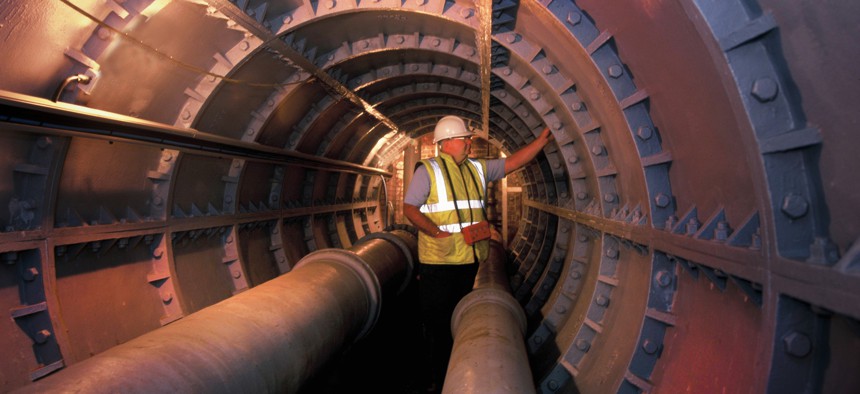Increasing visibility into municipal water systems

GettyImages/BRIAN MITCHELL
That combination of sensors, AI and edge computing unlocks previously unseen information in water systems that cities can use to find lost revenue.
There’s a classic Blue Man Group routine that begins with a serious, deep-voiced narrator describing a “virtually invisible network which links together millions of people.” Its “incredibly complex web of connections … represents one of the few ways all of our lives are intertwined.” Everyone nods in agreement, then comes the punchline: “This system is modern plumbing.”
It’s true, of course. The 50,000 or so public water systems in the United States represent a distributed network as complex as the internet. The difference is that we still don’t know where all the water goes after it leaves the treatment plants.
A Water Quality and Health Council report estimated that U.S. water utilities lose 16% of their water each year. Some aging and economically constrained systems—including several in and around Chicago—lose more than 30%. The report said that leaking pipes led to the loss of 25 billion gallons of water drawn from Lake Michigan in 2016.
It’s not an easy fix. Water systems are often completely independent and must stand up to rugged conditions: hot, humid and full of water. In many areas, they don’t have the luxury of a connection to any sort of private network that would help them improve performance or identify problems.
That’s now changing. The technology available in the industry—low-power edge computing chipsets, solar panels and battery technology—is finally maturing to the point where it can be deployed at scale. And the advent of artificial intelligence and machine learning has pushed the boundaries of what’s possible.
Today’s most advanced solutions put sensors right down into the commercial water meter pit. A visual sensor (a camera) reads the meter’s dial, a vibration sensor feels the water flow in the meter and pipe and a rotational sensor tracks the meter’s spin. Together, they collect performance data, much like sensors in modern cars.
Periodically, the system switches on its antennas to send data to the cloud. AI and machine learning algorithms then analyze the data, looking for trends in performance and identifying the fixes in the system that will deliver the most value.
That combination of sensors, AI and edge computing unlocks previously unseen information cities can use to find lost revenue. By pinpointing what needs to be fixed, which parts are needed to make the repair and validating the work was done correctly, the system creates tremendous efficiencies for water departments.
There’s also a long-term benefit that comes from continuous monitoring following the repair. Around 10% of commercial and industrial meters fail every year, and there’s no correlation between how long they’ve been in the ground and how they perform.
These technological advancements are coming along at a crucial time for cities as they struggle to balance their budgets. Last summer, a report from S&P Global Ratings found that municipalities affected by the severe drought could generate less income because there’s less water to sell, in turn affecting their credit rating and their ability to fund future projects.
By understanding where the water is going and how they can recover potential lost revenue, cities can avoid those types of budget problems while billing customers more equitably and providing better customer service.
The problem isn’t going away. A United Nations report said that 55% of the world’s population lives in urban areas today, and that's expected to increase to 68% by 2050. Cities will continue to look for ways to understand what’s happening in this last great distributed network. The first step is turning Blue Man Group’s “virtually invisible network” into a wholly visible one.
By Dave Mackie is CEO of Olea Edge Analytics.





